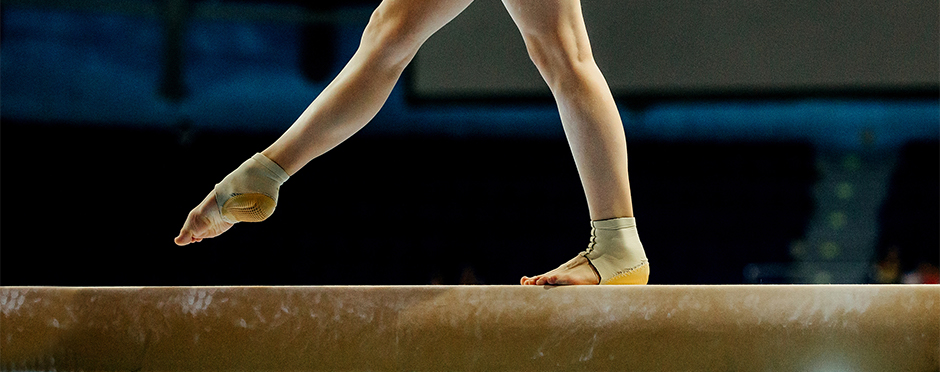
Achilles Tendinitis in Gymnasts
Leave a CommentTendinitis is a chronic, overuse type of injury that is common in gymnasts as they perform multiple repetitions of their routines – on the floor, beam and when sprinting toward the vault. Rhythmic gymnasts are also at risk due to performing up to four different routines on the floor with repetitive jumping, leaping and turning.
Achilles tendinitis is usually a strain at the insertion of the tendon into the heel bone or in the middle portion of the tendon. The calf muscles and the Achilles tendon are constantly being stressed and worked during gymnastic activity. The Achilles tendon helps to provide power when pushing off the foot. The Achilles tendon and calf muscles also provide the ability to perform on relevé, i.e. walking on the tiptoes, which is essential during gymnastic performances. The Achilles tendon is the large tendon at the back of the ankle. It connects the two main calf muscles, the gastrocnemius and the soleus, to the heel bone. Injury can occur at the attachment to the heel, the middle of the tendon, or up in the calf muscles themselves.
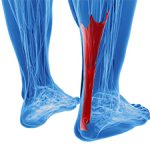 Gymnasts are at increased risk of Achilles tendinitis due to the nature of their sport: repetition of skills, sudden starts and stops, and repetitive jumping. Over time, it is thought that Achilles tendinitis leads to changes in the normal fiber arrangement of the tendon. Due to these changes, thickening can occur and the area can become less flexible. This can result in weakness of the tissue, which can lead to an increased risk of Achilles tendon rupture.
Gymnasts are at increased risk of Achilles tendinitis due to the nature of their sport: repetition of skills, sudden starts and stops, and repetitive jumping. Over time, it is thought that Achilles tendinitis leads to changes in the normal fiber arrangement of the tendon. Due to these changes, thickening can occur and the area can become less flexible. This can result in weakness of the tissue, which can lead to an increased risk of Achilles tendon rupture.
Symptoms of Achilles Tendinitis:
- Swelling over Achilles tendon
- Tenderness to palpation
- Decreased ankle range of motion- specifically ability to pull toes toward the nose (flex the foot upward)
- Painful to lift heels off ground
- Painful to push off when walking
- Painful to walk uphill or climbing stairs
- Pain and stiffness in area, especially after rest (ex: first thing in the morning)
- Pain with exercise
Treatment of Achilles Tendinitis for Gymnasts:
- Inform coaches or trainer about pain early on because earlier detection may help to shorten recovery time
- Possible immobilization (boot) per doctor recommendation
- Ice to help with swelling
- Medication for inflammation
- Limit walking, running, and jumping until pain is minimal
- Physical therapy can provide exercises for range of motion, flexibility of ankle and overall strengthening
Minimizing the Risk of Achilles Tendinitis in Gymnasts
The following exercises can help gymnasts minimize the risk of an acute flare up of Achilles tendinitis. Please note, if you are currently experiencing symptoms of Achilles tendinitis you should not perform these exercises unless doing so under the direction of your physical therapist.
Eccentric Heel Raise
Standing on the edge of a step, rise onto your toes using both feet. Then, lift one foot off of the step and lower your heel on the opposite foot. The foot performing the lowering is strengthening eccentrically. Perform 10-20 repetitions on both legs.
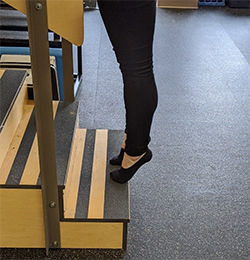
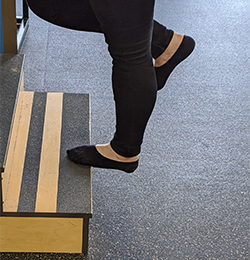
Gastrocnemius Stretching
Stand with both toes facing the wall, with your feet in a staggered position. Keep your back leg straight and heel on the ground. Bend your front knee until a stretch is felt in the calf of your back leg. Hold for 30 seconds. Perform 2-3 repetitions on both legs.
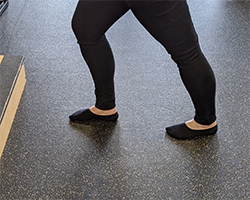
Soleus Stretching
Begin standing as if performing the above gastrocnemius stretch. However with this stretch, both knees will be bent. Heels should remain on the ground. The stretch will be felt in the back leg, lower toward the heel compared to the previous stretch. Hold the stretch for 30 seconds and perform 2-3 repetitions on both legs.
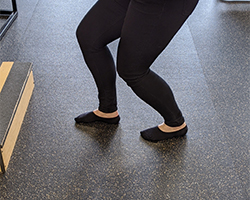
Self Massage
Many athletes find relief for tight calf muscles by performing a self massage. They may use a foam roller, stick roller or hand held massager to aide in “rolling out” tight muscles. With each of these options, the athlete has control over how much pressure is applied and therefore should avoid sharp pains.
Don’t Forget to Warm Up and Cool Down!
In order to prepare the muscles for activity, athletes should also perform a proper dynamic warm up that is sport-specific prior to practice or competition. Additionally, a good stretching cool down can help with recovery after activity. Gymnasts should be sure to include ankle and foot stretches during both warm up and cool down. Click here to read one of our previous blogs, which discusses ankle strengthening for tumbling athletes.
If you end up feeling pain or discomfort in your calf or heel, contact your nearest Athletico clinic for a free assessment.
The Athletico blog is an educational resource written by Athletico employees. Athletico bloggers are licensed professionals who abide by the code of ethics outlined by their respective professional associations. The content published in blog posts represents the opinion of the individual author based on their expertise and experience. The content provided in this blog is for informational purposes only, does not constitute medical advice and should not be relied on for making personal health decisions.
References:
1. Heitsman, Holly. “Achilles Tendonitis in Gymnastics.” USA Gymnastics, 2010, us-agym.org/pages/home/publications/technique/2010/01/28_tendonitis.pdf.
